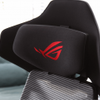Taking a closer look
A closer look
Assembling the ROG Destrier chair turned out to be more challenging than anticipated. While wrestling the heavy box through the door was relatively painless, the actual assembly process posed several difficulties. In this article, we'll delve into the assembly experience, highlighting the hurdles encountered and the overall complexity of putting the chair together.
The individual pieces of the ROG Destrier chair were securely packaged, ensuring their protection during transit. The package included a well-laminated page of instructions, providing both verbal and visual guidance for the assembly process.
The ASUS ROG Destrier features an imposing design, characterized by its towering profile, precise angles, and dark color palette that resonates with a technologically advanced aesthetic. Its striking armrests, composed of a powder-coated rectangular metal piece fitted into a gunmetal-grey bracket, offer an intriguing detail. The armrest adjustment mechanism resembles the motion of a sword being sheathed, contributing to the product's overall appeal.
The chair's back also adopts the same gunmetal grey finish, showcasing a spine inspired by biomechanical aesthetics. Starting from two separate points beneath the chair, the spine converges into a single strut before diverging to meet the shoulders. This arrangement and the muted mesh fabric form an overall design that is both inconspicuous and singular.
One design aspect of the ASUS ROG Destrier is the additional padding incorporated into the armrests' back, designed specifically to enhance the comfort of mobile gamers. However, its usefulness may be limited since mobile gaming contexts often don't involve the use of a gaming chair. The Destrier chair utilizes a fabric mesh suspension system, rather than padding, which provides a unique level of comfort.
Lumbar support, a key aspect of the Destrier's design, can be fine-tuned using two knobs. This fabric-covered component provides a 7cm range of vertical adjustment for optimal alignment with the user's back, and a 2cm fore-aft adjustment to tailor the intensity of pressure or support.
The seating area measures 22.44 inches in width and 19.68 inches in depth (570mm x 500mm), facilitating movement and various seating positions. A noteworthy feature is the ample space for crossing legs on the chair, albeit an unorthodox and non-ergonomic posture.
The chair also features a headrest with a substantial degree of customization. It supports a depth range of up to 6cm and a height adjustability of up to 12cm.








